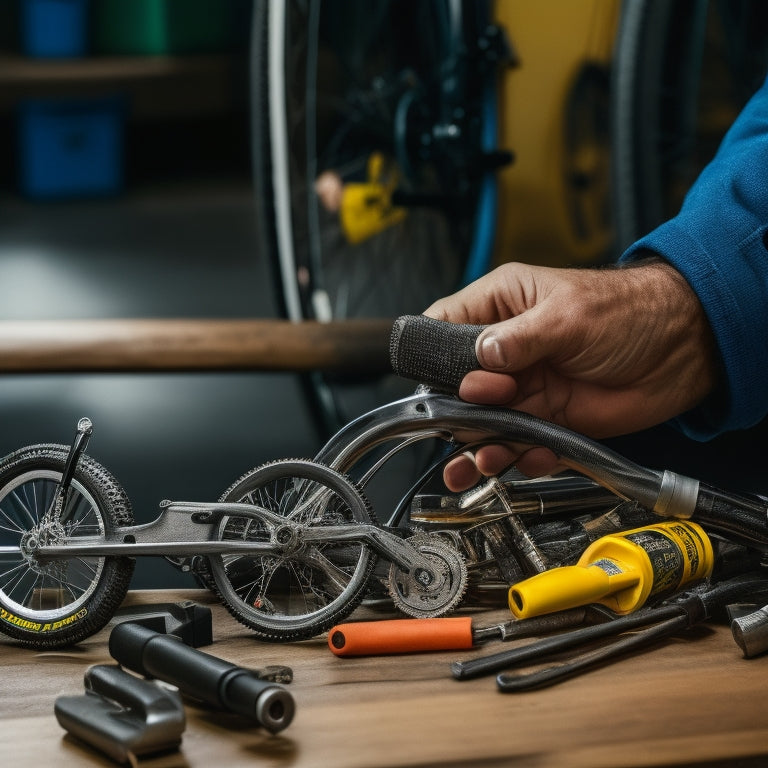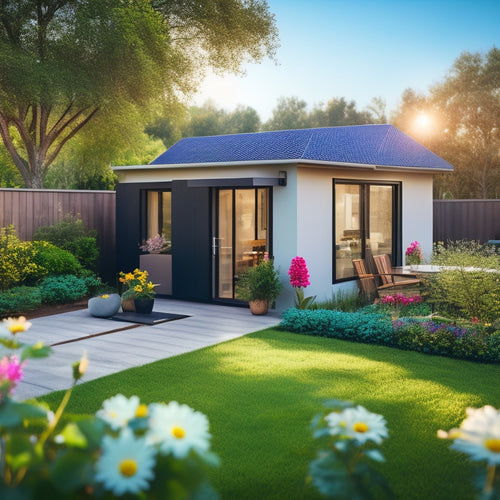
Convert Your Folding Bike to Electric With Ease
Share
You can convert your folding bike to electric with ease by selecting a compatible conversion kit that matches your bike's wheel size, gear type, and brake configuration, an important step that guarantees a seamless and safe shift to an e-bike. To guarantee a smooth conversion, you'll need to understand your bike's specs, prepare your bike, and install the electric motor system. You'll also need to select the ideal battery type, mount it securely, and integrate the electronic controls. With precision and patience, you can successfully convert your folding bike and enjoy a more efficient ride. Get ready to maximize your bike's full potential.
Key Takeaways
• Consider wheel size, gear type, and brake configuration when selecting a conversion kit to ensure compatibility and prevent issues.
• Understand your folding bike's specs, including frame materials, gear ratios, wheel size, and brake configuration, to ensure a smooth conversion process.
• Inspect your bike before conversion to identify safety risks, optimize performance, and detect worn or damaged parts.
• Choose a motor system with a compatible hub motor, controller, and battery, considering factors like energy density, safety, and cycle life.
• Follow a methodical approach to installation, testing, and fine-tuning to ensure a seamless and safe electric bike conversion.
Choosing the Right Conversion Kit
When shopping for a conversion kit, you'll need to drill down into the specifics of your folding bike's make, model, and components to guarantee a seamless integration with the electric system. This means considering factors like wheel size, gear type, and brake configuration to make certain the kit you choose is compatible with your bike.
Kit compatibility is essential, as an incompatible system can lead to poor performance, safety issues, or even damage to your bike.
Budget constraints also play a significant role in your decision. Conversion kits can range from a few hundred to several thousand dollars, depending on the quality and features of the system. You'll need to balance your budget with your performance expectations, considering factors like motor power, battery life, and accessories like throttles and displays.
Understanding Your Folding Bike's Specs
To guarantee a successful conversion, you'll need to intimately familiarize yourself with your folding bike's specifications. This includes its wheel size, gear type, and brake configuration. This knowledge will help you choose the right electric conversion kit and make sure a seamless integration.
Here are 4 key specs to focus on:
-
Frame materials: Is your frame made of aluminum, steel, or carbon fiber? This affects the weight capacity and compatibility with electric components.
-
Gear ratios: What's your bike's gear setup? Is it a single-speed, internal gear hub, or derailleur system? This impacts the motor's gear compatibility and your riding experience.
-
Wheel size and type: Are your wheels 16, 20, or 24 inches? Are they rim brakes or disc brakes? This information helps you select the correct motor and brake configuration.
- Brake configuration: Do you have rim brakes, disc brakes, or a combination of both? This determines the type of brake sensors and motor inhibitors required.
Understanding these specifications ensures a smooth conversion process and a reliable, high-performing electric folding bike.
Preparing Your Bike for Conversion
As you prepare your folding bike for electric conversion, you'll need to meticulously inspect your bike's components and gather essential tools for the task ahead.
You'll want to create a bike inspection checklist to identify potential issues and guarantee a smooth conversion process.
Bike Inspection Checklist
You should meticulously inspect your folding bike's essential components, including the frame, wheels, brakes, and gears, to identify any worn or damaged parts that may impact the electric conversion process. This thorough examination is important to guarantee a smooth and safe conversion.
Conducting a bike inspection checklist will help you:
-
Identify safety risks: Check for any broken or damaged components that could compromise your safety while riding.
-
Perform wear analysis: Inspect the bike's components for signs of wear, such as rust, corrosion, or excessive wear on brake pads and tires.
-
Detect potential conversion hurdles: Identify any parts that may need to be modified or replaced to accommodate the electric conversion kit.
- Optimize performance: Ensure that your bike is in good working condition to maximize the performance of the electric conversion kit.
Essential Tool Gathering
Before plunging into the electric conversion process, gather all necessary tools and materials to guarantee a seamless and efficient transformation of your folding bike. You'll need a well-stocked toolbox to tackle the task at hand. Organize your tools by category, allocating separate compartments for wrenches, pliers, screwdrivers, and other essentials. A logical Toolbox Organization system will save you time and frustration in the long run. Make sure your Workshop Layout is ergonomic and functional, with ample space to disassemble and reassemble your bike.
Familiarize yourself with the components you'll be working with, including the motor, controller, and battery. Make a checklist of the materials you'll need, such as wiring, connectors, and mounting hardware. Don't forget to stock up on safety gear, including gloves, safety glasses, and a first-aid kit. A methodical approach will help you stay focused and avoid costly mistakes.
With your tools and materials at the ready, you'll be well-prepared to commence the electric conversion journey.
Installing the Electric Motor System
As you prepare to install the electric motor system, you'll need to follow a series of precise steps to guarantee a seamless integration with your folding bike's existing components.
You'll need to familiarize yourself with the motor system's components, including the motor itself, controller, and battery.
Motor Installation Steps
The electric motor system's installation begins with securely mounting the hub motor to the folding bike's front or rear wheel, depending on the desired configuration. Confirm motor compatibility with your folding bike's specifications to avoid any installation hurdles.
Next, you'll need to tackle wiring challenges, connecting the motor to the controller and battery. This step demands attention to detail and patience to prevent any electrical mishaps.
Here are the essential motor installation steps to follow:
-
Mount the hub motor: Securely attach the motor to the wheel using the provided hardware.
-
Connect the motor wires: Link the motor wires to the controller, ensuring correct polarity and secure connections.
-
Route the wiring: Organize the wiring to minimize exposure and reduce the risk of damage.
- Test the motor: Verify the motor's functionality before proceeding with the rest of the conversion process.
Motor System Components
You'll need several key components to complete the electric motor system, including a compatible hub motor, a controller, a battery, and a throttle. The hub motor is the heart of the system, providing the power and torque to propel your bike. Look for a motor with high motor efficiency to maximize your battery life. The controller regulates the flow of power to the motor, ensuring a smooth ride. Your battery choice will depend on your range and power requirements, so consider factors like voltage, capacity, and type.
| Component | Function | Key Considerations |
|---|---|---|
| Hub Motor | Propels the bike | Motor efficiency, Gear ratios |
| Controller | Regulates power flow | Compatibility, Peak current |
| Battery | Stores energy | Capacity, Voltage, Type |
When selecting these components, consider your specific needs and goals. For example, if you prioritize speed, you may opt for a higher-powered motor and controller. If you need to tackle steep hills, consider a motor with a higher gear ratio. By carefully choosing each component, you'll create a harmonious and efficient electric motor system that enhances your folding bike.
Selecting the Ideal Battery Type
Your electric folding bike's performance hinges on the battery type, which is why selecting the ideal one is crucial. As you explore the market, you'll come across various options, each with its strengths and weaknesses. To make an informed decision, consider the following key factors:
-
Energy Density: This measures a battery's energy storage capacity relative to its weight and volume. A higher energy density means a more efficient battery.
-
Battery Safety: Look for batteries with built-in safety features, such as overcharge protection and thermal management systems, to guarantee safe and reliable operation.
-
Cycle Life: This refers to the number of charge/discharge cycles a battery can handle before its capacity degrades. A higher cycle life means a longer-lasting battery.
- Compatibility: Make sure the battery is compatible with your motor system and other components to avoid integration issues.
Mounting the Battery and Cables
Secure the battery to the frame or a suitable mounting point, making sure it's easily accessible for maintenance and charging while keeping cables organized and protected from damage. This is vital to guarantee efficient battery placement and cable management.
You'll want to choose a location that provides easy access for charging and maintenance, while also safeguarding the battery from the elements and potential damage.
When mounting the battery, make sure to use sturdy brackets or straps that can securely hold the battery in place. You should also consider the weight distribution of the bike and ensure the battery is mounted in a way that maintains the bike's balance and stability.
Proper cable management is also crucial to prevent damage and ensure the electrical system functions smoothly. Route cables neatly along the frame, using cable ties or zip ties to keep them organized and secure. Avoid routing cables near moving parts or areas prone to moisture.
Integrating the Electronic Controls
Integrating the electronic controls involves carefully selecting and installing components that regulate the electric bike's performance, ensuring a seamless riding experience. This is where you'll bring all the electrical components together to create a harmonious system.
To achieve this, you'll need to focus on the following key aspects of electronic integration:
-
Wire Harness: Design and install a wire harness that securely connects all electrical components, ensuring reliable communication between them.
-
Controller Configuration: Program the controller to optimize the bike's performance, taking into account factors like speed, torque, and battery life.
-
Sensor Integration: Install sensors that monitor the bike's speed, pedal assist, and battery level, providing real-time feedback to the controller.
- Display and Interface: Set up a user-friendly display and interface that allows you to monitor and adjust the bike's settings on the go.
Testing and Fine-Tuning Performance
With the electronic controls integrated, you can now power up the bike and begin testing and fine-tuning its performance. This is where you'll refine the bike's calibration to optimize its electric assist. Start by checking the bike's performance metrics, such as speed, torque, and battery life. Take note of any discrepancies or areas for improvement.
Next, apply calibration techniques to fine-tune the bike's systems. This may involve adjusting the motor's power output, tweaking the gear ratios, or optimizing the battery's charging cycle.
As you test and refine, keep a log of your adjustments and their corresponding effects on the bike's performance.
Safety Precautions and Maintenance Tips
As you've refined your bike's performance, it's equally important to prioritize safety and maintenance to guarantee that your electric folding bike operates reliably and efficiently over time.
To make sure a safe and enjoyable ride, don't forget to:
-
Always wear a helmet: A helmet is the most critical safety gear for any cyclist, and it's especially important when riding an electric bike, which can reach higher speeds.
-
Conduct regular chain cleaning: A clean chain ensures smooth gear shifts and prevents corrosion, reducing the risk of mechanical failure.
-
Check tire pressure: Properly inflated tires improve traction, stability, and overall safety.
- Inspect brakes and electrical connections: Regularly check your brakes and electrical connections to make sure they're functioning correctly and safely.
Frequently Asked Questions
Can I Convert My Folding Bike to Electric Myself or Do I Need a Professional?
"If you possess decent DIY skills, you can convert your folding bike to electric yourself using conversion kits, but if you're not comfortable with technical tasks, it's best to consult a professional for a seamless installation."
Will an Electric Conversion Void My Folding Bike's Warranty?
As you ponder the electric conversion, you're wise to wonder: will it void your warranty? Hold your breath - it depends on your manufacturer's policy. Conduct a warranty check and scrutinize the fine print to uncover the verdict.
How Much Does It Cost to Convert a Folding Bike to Electric?
You'll spend between $500 to $2,000 to convert your folding bike to electric, depending on the kit and quality. Conduct a budget analysis to determine the cost-benefit ratio, weighing the cost of components against your riding needs.
Can I Still Fold My Bike After the Electric Conversion?
You'll be relieved to know that, with careful planning, you can still fold your bike after the electric conversion, as long as you consider folded dimensions, strategic battery placement, and minimal frame modifications, ensuring portability and convenient storage options.
Is an Electric Conversion Suitable for All Types of Folding Bikes?
You'll find that not all folding bike types are suitable for electric conversion, as some frames or hinges may not provide the necessary structural integrity for electric compatibility, so choose wisely.
Related Posts
-

Top Picks: Van-Friendly Panel Kits to Buy Online
You're about to hit the open road, and you need a reliable source of power to keep your van's essentials running smoo...
-

What's the Best Green Ride for College Budgets?
As a college student on a budget, you're likely looking for an eco-friendly ride that won't break the bank. You've go...
-

Best Online Solar Panel Systems for Small Homes
When choosing the best online solar panel system for your small home, consider top-rated brands like SunPower, Panaso...


